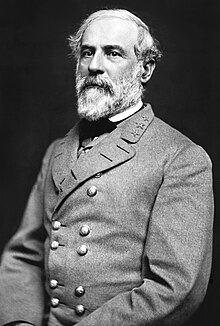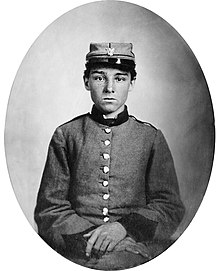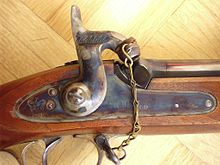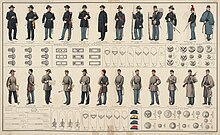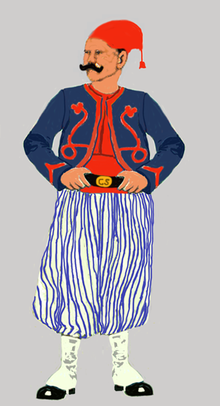Confederate States Army
|
Army of the Confederate States |
|
|---|---|
| active | February 28, 1861 to 1865 |
| Country |
|
| Armed forces | Confederate Armed Forces |
| Armed forces | army |
| Commander in chief | |
| From 1865 | General Robert Edward Lee (General in Chief of the Armies of the Confederate States) |
| insignia | |
| Official flag of war from March 4 to May 26, 1865 |

|
The Confederate States Army , or CSA for short , was the army of the Confederate States of America , which had split off from the United States of America , during the Civil War . The Confederate Army was created to defend the Confederate States against Union forces .
The Confederate States Congress approved the formation of a Volunteer Army ( Provisional Army of the Confederate States , PACS ) on February 28, 1861 and that of a professional army ( Army of the Confederate States of America (ACSA)) on March 6, 1861 . The latter should include 15,015 soldiers, although this never fully succeeded. There were also militias from the individual states . In the course of the war the total number of active soldiers never exceeded about 460,000 men.
Commander in chief
The President of the Confederate States , Jefferson Davis , a graduate of the Military Academy at West Point , New York , set the strategic goals. Davis also served as the de facto Commander in Chief of the Army during much of the war. However, Generals Robert Edward Lee (March – April 1862) and Braxton Bragg (February 1864 – January 1865) were temporarily appointed as military advisers to the President and as such had authority over the entire Confederate Army. The creation of a dedicated commander in chief for the entire army had been debated in the Confederate Congress since 1862, but was not implemented until January 1865. On January 23, Congress created the office of General in Chief of the Armies of the Confederate States , to which on January 31, Robert Edward Lee was appointed. The Ministry of War implemented the requirements of the President and his adviser.
The highest ranking officer in the army was General Samuel Cooper . He held the function of inspector general and adjutant general .
composition

At the beginning of the Civil War, the Confederate Army, like the Union Army, was a purely voluntary army. The tribe was composed of the respective militia troops of the individual states. In March 1861, Congress approved posts for 100,000 one-year volunteer soldiers. Within a month, more than a third were under arms. The rush of volunteers was so strong that during this period double the number could easily have been accepted, but the necessary armament and equipment were lacking.
With the duration of the war and the defeats in the spring of 1862, the enthusiasm for voluntary reports waned. For example, Congress passed the first conscription law in American history, which came into effect in April 1862. White men aged 18 to 35 were drafted for the duration of the war. In the months that followed, the age of compulsory military service was gradually increased. With the Third Conscription Act of February 17, 1864, all white men between 17 and 50 years of age were finally drafted, but the 17-18 year olds and the 45-50 year olds formed the reserve (partly divided into Junior Reserves and Senior Reserves ) should only be used in their home state. In these laws, wealthy citizens were given preferential treatment. They were entitled to send deputies to military service or to buy themselves out. The law of 1862 also provided that one man was released for every plantation with at least 20 slaves. The conscription of slaves was politically very sensitive and was only made possible by law in March 1865 .
The bulk of the Confederation Army was formed by the Provisional Army of the Confederate States , which roughly corresponded to the voluntary army of the Northern States and was to be disbanded after a successful outcome of the war. A few units and officers served in the Army of the Confederate States of America , which was to form the core of a new, regular Confederate army after the war. A third group were militias that were formed at the state level and often only deployed there.
A total of 850,000 to 900,000 men served in the army of the Confederate States, due to a lack of documents there are no precise details. The daily duty force never exceeded 460,000 men. The ranks and functions corresponded to those of the US Army. Around 260,000 soldiers of the Confederate Army died as a result of fighting, its consequences, illness or other reasons.
organization

Infantry , artillery and cavalry were the main branches of the army in the southern states. In addition, there were special troops at the army and corps level , which were led by generals and staff officers responsible for the special task with small staffs. This included the Corps of Engineers , roughly comparable to today's pioneer troops , topography - (later merged with the pioneer troops), telecommunications and logistics troops , the medical service as well as staff and leadership troops such as the field judiciary and the adjutants.
An army led two to four corps; the commander in chief was usually a general . A corps led two to six divisions ; the commanding general was mostly lieutenant general . In addition, the army and corps led command and combat support troops . The corps level was not introduced until 1862; previously were in wings (Armeen wings subdivided).
The division led two to six brigades ; the division commander was usually major general . Divisions only formed as the war progressed. Before that, the level directly subordinate to the army was the brigade. A brigade led three to six regiments , which usually came from a single state. The brigade commander was usually a brigadier general . At the beginning of the war, each brigade was under an artillery battery. Regiments were largely formed from male citizens of a state or even a region within a state. Attempts were also made to recruit the replacement from the same area. This was intended to strengthen the spirit of the corps. Each regiment had its own regimental flag. The regimental commander usually had the rank of colonel .
The most appropriate form of structure did not begin to emerge for all armies until the beginning of 1863 and was not uniform. It depended in large part on the preferences of the Commander-in-Chief, but in any case required the approval of Congress and the President. The frequent changes in the organization repeatedly led to uncertainties in the management and in the execution of orders.
In addition, the territory of the Confederation was divided into defense areas called "Departments". The size of the defense areas could vary from several states (e.g. the Trans-Mississippi Defense Area with the states of Arkansas and Texas , western Louisiana and the Indian Territory ) to small areas (e.g. the Richmond Defense Area , Virginia ) . Defense areas were often divided into several military districts . The geographical composition of the defense areas was based on the current course of the war and therefore changed frequently. All troops in the military area were subordinate to the commander in the military area. Therefore he was mostly commander in chief of the army deployed in the defense area. If there were several armies in the military area (e.g. the Tennessee and Mississippi armies in the western military area ), the commander was authorized to give instructions to the commanders in chief of the armies, but did not have troops directly subordinate to him himself. The armies themselves also received orders directly from the President and the Minister of War.
Officers
306 of the graduates of the military academy still alive at the outbreak of the war , which corresponds to about a third, served in the Confederate army. But even the officers with West Point training had seldom got beyond the command of a company or battery . B. Lee as regimental commander of a cavalry regiment or Joseph E. Johnston as deputy regimental commander. Johnston was the only US Army general to convert to the Confederate Army. Generals were appointed to their posts by the government. A third of the generals had been entrusted with military posts because of their party affiliation, seven of these had no military training. Most of their leaders learned the professional leadership of the divisions, corps and armies through practical experience and high casualties among their soldiers.
The governors appointed the regimental commanders. In the companies of the voluntary troops, officers were elected in principle. In addition, the state from which the regiment came could use officers on duty.
| Ranks | artillery | infantry | cavalry | Engineering corps |
|---|---|---|---|---|
| general | $ 301 | |||
| Colonel | $ 210 | $ 195 | $ 210 | $ 210 |
| Lieutenant colonel | $ 185 | $ 170 | $ 185 | |
| major | $ 150 | $ 150 | $ 162 | $ 162 |
| Captain | $ 130 | $ 130 | $ 140 | $ 140 |
| First lieutenant | $ 90 | $ 90 | $ 100 | $ 100 |
| lieutenant | $ 80 | $ 80 | $ 90 | $ 90 |
infantry

The infantry was the largest and most decisive force in the fight. The military home of the infantryman was the regiment, which consisted of ten companies with a nominal strength of 100 men, the regimental strength was 1,045 men.
The infantry consisted of 642 regiments, nine legions, 163 independent battalions and 62 independent companies.
The infantry carried the brunt of the fight and marched into battle. The normal day of the march began at dawn and lasted until the afternoon. The marching performance was typically two and a half miles per hour, around 4 km / h as the normal speed for large marching formations. The infantryman carried all of his equipment - 60 pounds (equivalent to about 27 kg) - and the roughly 10 pound (equivalent to 4.5 kg) rifle. The Confederate infantry consisted for the most part of small plantation owners, farmers and so-called hillbilly 's (hillbilly, country egg), an often derogatory term for residents of the rural, mountainous areas of the southern states. They shaped the combat troops through their peculiarities such as lust for battle, physical hardship, excessive self-confidence and a great tendency to indiscipline.
artillery
At the beginning of the war the artillery was subordinate to the brigades, with one battery for each infantry brigade. This deprived them of the concentrated firepower that reached the Union with their massed batteries. In the winter of 1862/63, the batteries were combined into artillery battalions at corps and army level in order to be able to form clear focal points by assigning them to divisions. The artillery pieces and grenades manufactured by the Confederation never reached the quality of the artillery of the Union Army. The artillery supported the infantry directly; the closed use remained the exception z. B. the use of artillery on the third day of the Battle of Gettysburg .
An artillery battery consisted of up to 80 men and 4 guns. Often times, even in the battery, the guns were not of the same type and sometimes had different calibers.
The Mounted Artillery (Horse Artillery) differed from the rest of artillery that not only the guns were covered, but also the operations were mounted. Mounted artillery batteries were assigned exclusively to the cavalry.
The artillery had a total of 40 regiments and 66 battalions, which were organized in 351 batteries and companies.
cavalry
The cavalry was primarily used for reconnaissance and shielding of its own units and also often carried out raids in the enemy hinterland. With increasing duration of the war, the cavalry also fought increasingly dismounted. A cavalry regiment consisted of 10 companies of 76 men each. Sometimes cavalry battalions with fewer companies also emerged. Several cavalry regiments formed a brigade that could be combined into divisions.
The armies had one or more cavalry divisions, whose brigades were also dependent on cooperation with the infantry divisions. From 1863 the cavalry divisions were combined to form cavalry corps.
The cavalry had 137 regiments, 1 legion, 143 independent battalions and 101 independent companies.
Armament
infantry
The standard infantry weapon was the Pattern 1853 Enfield Rifled Musket .577 caliber imported from Great Britain . From the weapon, a musket with a rifled barrel , the same ammunition could be fired as from the standard weapon of the Union, the Springfield Model 1861 (Rifled Musket) in caliber .58. The weapon was loaded from the front, had a percussion ignition and fired Minié projectiles . A bayonet could be attached to the front of the rifle . The armament of the infantry was very inconsistent and partly differed from regiment to regiment. At the beginning of the war, the recruits often brought their own weapons. These were mostly outdated muskets and even shotguns, but also modern bolt-action rifles.
Despite the blockade by the Union fleet, the Confederate States imported half a million rifles, thousands of tons of gunpowder and a few hundred artillery pieces, mostly from Great Britain, but also from France and various German states . In addition to the Enfield, there were also many Austrian Lorenz infantry rifles M.1854 available. In addition, the soldiers captured weapons from soldiers of the Union Army on the battlefields. This multitude of weapons led to a large number of different calibers for which the corresponding cartridges had to be manufactured. The armament of the infantry in the eastern theater of war was more modern than on the others.
Multi-shot breech-loaders were already available at the beginning of the war. However, the leadership largely refrained from introducing these weapons to the infantry because they feared increased ammunition consumption, technical problems with the weapons and ammunition and the associated increased costs. There was also a fundamental shortage of metals in the Confederation.
The southern states used oval or spherical hand grenades made by Rains and Adams. These weighed 1–5 pounds and some had a kind of tail unit (wooden shaft and cardboard fletching), strips of fabric or long paper loops at the end to stabilize the trajectory. The Confederate Rain hand grenade was essentially the same as the Northern ketchum grenade, except that it had no disc at the tip of the detonator.
artillery
The artillery had a similar variety of weapons. The “workhorse” of the field artillery was the twelve-pounder M 1857 Napoleon gun made of bronze and with a smooth barrel. In addition, numerous rifled guns such as the 3-inch Ordnance Rifle or Parrot guns and even some British breech loaders were used. At the beginning of the war and in poorly equipped theaters of war, outdated six-pounder cannons or twelve-pounder howitzers from stocks of the US Army were often used. The guns fired full projectiles, explosive projectiles and grapefruit / shrapnel ("Shrapnel" and "Canister"). The waitress consisted of nine men.
cavalry
The Confederate cavalrymen were usually armed with a saber , a revolver and a carbine or shotgun . The lack of supplies often forced the cavalrymen to stock up on booty weapons. However, the usefulness of these weapons, such as the Sharps Rifle or the Spencer Repeating Rifle, was reduced by the difficulty of keeping sufficient ammunition available due to the shortage of materials. In contrast to the US Army, horses had to be brought by the riders themselves and replaced if necessary, for which prey horses were also used.
The cavalry could be used both mounted and infantry. The decision on this was made by the respective commanders depending on the circumstances on site. The attack with drawn saber remained the exception (e.g. in the battle of Brandy Station ). The cavalry was basically used like dragoons, moved on horseback, fought dismounted.
Uniforms
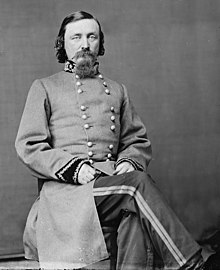
The uniformity of the CSA was subject to certain regulations, but for various reasons uniformity was seldom achieved even within the smallest of troops. According to the regulations, the uniform should generally consist of long, gray tunic skirts , medium blue trousers and the so-called képis as headgear . However, the army was not a homogeneously grown unit, but initially a conglomerate of the militias of the various states, who wore uniforms according to their own taste, although the gray predominated. In addition, there were the units set up by the cities or counties or even wealthy private individuals, whose uniforms were mostly designed according to the specifications and / or financial possibilities of the donors. Examples:
- "Wheats Tigers": (1st Louisiana Special Battalion) A battalion from New Orleans set up privately by Ribodeaux Wheat , which was uniformed in the style of the French Zouaves .
- The "Palmetto Guard" of the 2nd South Carolina Infantry Regiment wore black uniforms with a hat with the right brim turned up. When the unit was converted to the 1st Company of the 2nd South Carolina Volunteers, the uniforms also had to be adapted to the standard.
- "Lynchburg Home Guard" of the 11th Virginia Infantry Regiment: instead of blue, gray trousers, the officers wore epaulettes with cantilles instead of badges on their collars .
- "Clinch Rifles" of the 5th Georgia Infantry Regiment: The A company of the regiment was dressed in completely green uniforms with sleeve flaps in the style of the Guard Grenadiers of the Kingdom of Westphalia . The officers wore the insignia of rank based on the pattern of the northern states, with two bars not standing for captain (captain), but for first lieutenant (first lieutenant). The other companies in the regiment were also equipped with different uniforms (blue and gray skirts), which gave the regiment a certain degree of recognition and was called "pound cake" by General Braxton Bragg .
- " Virginia Military Institute ": The officers wore dark blue tunics.
- "11. Mississippi Infantry Regiment ”: Gray uniforms with red collars, cuffs and tucks. The tunic had a row of red braids running across the chest, the end of which was decorated with a button. As a result, the tunic had three rows of buttons, plus a black hat with the brim turned up on the right.
- "1. South Carolina Cavalry Regiment ”: Gray uniforms with black collars, cuffs and tucks. Instead of the tunic, a short jacket (shell jacket) was worn. It had a row of black braids running across the chest, the end of which was decorated with a button, so the jacket had three rows of buttons, a black hat with a brim turned up to the left and a black ostrich feather.
- The "Ogelthorpe Light Infantry" wore a uniform in the style of the Uhlans with a discount on the chest and a shako with a white plume.
- The "Washington Light Artillery of New Orleans" wore dark blue tunics and badges of rank based on the northern states.
The front of képis and hats had various badges:
- a metal palm, the insignia of South Carolina
- a silver star for the Texans
- a hunter's horn for the rifles (hunters)
- a CR in the oak leaf wreath for the clinch rifles
- NC for North Carolina
As in the Union Army, colors were prescribed for the branches of arms, this concerned the collar, the cuffs, the piping on the trousers (if available), the color of the képis and the color of the badges of rank for the men and non-commissioned officers:
- Infantry - light blue
- Artillery - red
- Cavalry - yellow
However, this was more of a theoretical nature and was mostly only used for units that had been set up directly by the War Department.
With increasing scarcity of materials, however, all these decorations disappeared, if they were still issued at all, the long tunics were replaced by the short shell jackets. The uniforms were increasingly made of a coarse brown-colored material called "homespun". The brown color - called "butternut" in soldiers' jargon - replaced gray more and more in the course of the war. From around the end of 1862 the supply situation became so bad that the soldiers appeared in large numbers in so-called robber's civilian clothes, missing uniforms were replaced by civilian clothing of all colors, which gave the troops the appearance of robber gangs. From the end of 1863 there were neither uniform parts nor shoes on the supply route, which forced many soldiers to walk barefoot. Because North Carolina produced its own textiles, the troops from that state were among the best-dressed units in the Confederate and were probably the most uniformly dressed within their regiments. Virginia ranked second after North Carolina for best-equipped and dressed regiments according to government guidelines. However, as the war lasted longer and more, improvisations became more and more important. Obedient to the need, captured northern uniform parts were also used. Sabers, saber belts and other weapons were used in every case.
particularities
- Many former officers of the US Army continued to wear their blue uniform for a long time.
- In general, little importance was attached to compliance with the regulations (and not just because of the scarcity of materials). For example, General Lee's tunic and hat were not in accordance with the regulations.
- A good dozen of the Northern States associations also wore gray uniforms such as the “11. Indiana Infantry Regiment ”or the“ Guthrie Grays ”from Cincinnati .
- The confusion caused by the non-uniform uniformity meant that a gray uniformed northern regiment was shot at by its own people at least once , while in another case a “blue” southern regiment was recognized too late as an enemy.
- The origins of the sleeve decorations of the southern officers can be traced back to the Vitéz Kötés of the Hungarian hussars , but the chosen shape shows French influence. This seems to be the parade uniform, but they can hardly be seen in the relevant photos that were taken after the fighting began.
- Likewise, the képis for the officers with their decorative piping and decorative loops on the lid were taken over by the French army.
- Referring to the color of the uniforms, the soldiers of the two armies (in addition to Billy Yank and Johnny Reb ) also referred to each other as "bluebellies" (blue bellies) and "graybacks" (gray backs).
Rank badge
The ranks and functions corresponded to those of the US Army.
| Officers | ||||||||||
|---|---|---|---|---|---|---|---|---|---|---|
| all generals | Colonel | Lieutenant Colonel | major | Captain | First lieutenant | Second lieutenant | ||||

|
|
|
|
|
|
|
||||
| Sergeants, NCOs and men | ||||||||||
|---|---|---|---|---|---|---|---|---|---|---|
| Sergeant Major | Quartermaster Sergeant | Ordnance Sergeant | First sergeant | |||||||

|

|

|

|
|||||||
| sergeant | Corporal | Musician | Private | |||||||

|

|
no badge of rank | no badge of rank | |||||||
References
See also
literature
- Giampiero Carocci: Brief History of the American Civil War. The incursion of industry into the craft of war. Wagenbach, 1998, ISBN 978-3-8031-2281-0 .
- John H. Eicher, David J. Eicher: Civil War High Commands . Stanford University Press, 2001, ISBN 0-8047-3641-3 .
- James M. McPherson : Battle Cry of Freedom . Oxford University Press, New York 2003, ISBN 0-19-516895-X .
- James M. McPherson: Die for Freedom. The history of the American Civil War . Anaconda-Verlag, 2008, ISBN 3-86647-267-6 .
- William Glenn Robertson et al .: Staff Ride Handbook for the Battle of Chickamauga September 18-20, 1863, 1992. US Army Command and General Staff College. Combat Studies Institute. E475.8l.S73 as a PDF document .
- Marcus Junkelmann: The American Civil War, 1861–1865. Weltbild, Augsburg 1992, ISBN 3-89350-355-2 .
Web links
Notes and individual references
- ^ John H. and David J. Eicher: Civil War High Commands. Stanford University Press, 2001, accessed November 8, 2020 (Lees' life data, p. 344).
- ↑ The War of the Rebellion, Series I, Volume XLVI, Part II, p. 1205 f: General Orders No. 3
- ↑ Eicher and Eicher, Civil War High Commands , p. 69
- ↑ Cooper was not authorized to give instructions to the army. General Albert Sidney Johnston followed him in the order of precedence. Until his death on April 6, 1862 at the Battle of Shiloh, Johnston was the highest-ranking general who led troops in the field. For example, out of respect for the senior, General Lee Cooper reported most of his decisions.
- ↑ Confederate Conscription Act of February 17, 1864, Section 5: An act to organize forces to serve during the war.
- ^ Giampiero Carocci: Brief History of the American Civil War, p. 73.
- ↑ James McPherson: Battle Cry of Freedom, p. 306 f.
- ↑ James McPherson: Battle Cry of Freedom, p. 326
- ↑ Remuneration of the officers. University of North Carolina at Chapel Hill, 2001, accessed on March 13, 2012 (The Statutes at Large of the Provisional Government of the Confederate States of America, Chap. XXIX, Sect. 13ff).
- ↑ Legions were regiments capable of combined forces operations , consisting of infantry, artillery and cavalry units. As the war went on, they lost this ability.
- ↑ Junkelmann 1992, p. 94.
- ↑ James McPherson: Battle Cry of Freedom, p. 320
- ^ Battle Units - Artillery. National Park Service, August 17, 2016, accessed April 14, 2020 .
- ↑ James McPherson, Battle Cry of Freedom, p. 380
- ^ "Brady's Civil War" The Lyons Press Guilford CT p. 54
- ↑ It consisted mostly of criminals and bush thieves and was notorious for its fighting power and ruthless behavior
- ^ "The Civil War" Part I & II by Black Dog & Levethal New York 1983 Part I, p. 191.
- ^ "The Civil War" Part I & II by Black Dog & Levethal New York 1983 Part I p. 93
- ^ William C. Davis: The American Civil War - Soldiers, Generals, Battles, ISBN 3-8289-0384-3 , p. 11
- ^ "Battlefield of the Civil War" Salamander Books Ltd. London 1988 p. 15
- ^ "Battlefield of the Civil War" Salamander Books Ltd. London 1988 p. 120
- ^ "Battlefield of the Civil War" Salamander Books Ltd. London 1988 p. 1192
- ^ "Battlefield of the Civil War" Salamander Books Ltd. London 1988 p. 125
- ^ "Battlefield of the Civil War" Salamander Books Ltd. London 1988 p. 197
- ^ "The Civil War" Part I & II by Black Dog & Levethal New York 1983 Part I p. 60
- ^ "The Civil War" Part I & II by Black Dog & Levethal New York 1983 Part I p. 200
- ^ "Battlefield of the Civil War" Salamander Books Ltd. London 1988 pp. 48/89
- ^ "Battlefield of the Civil War" Salamander Books Ltd. London 1988 p. 127
- ^ "The Civil War" Part I & II by Black Dog & Levethal New York 1983 Part I p. 40
- ^ William C. Davis: The American Civil War - Soldiers, Generals, Battles, ISBN 3-8289-0384-3 , pp. 15 and 73
- ^ "The Civil War" Part I & II by Black Dog & Levethal New York 1983 Part I p. 88
- ^ "Battlefield of the Civil War" Salamander Books Ltd. London 1988 p. 129
- ^ "The Civil War" Part I & II by Black Dog & Levethal New York 1983 Part I p. 599.
- ^ "Battlefield of the Civil War" Salamander Books Ltd. London 1988 p. 35
- ^ "The Civil War" Part I & II by Black Dog & Levethal New York 1983 Part I p. 59
- ^ "Battlefield of the Civil War" Salamander Books Ltd. London 1988 p. 107.
- ^ "Battlefield of the Civil War" Salamander Books Ltd. London 1988 p. 1229.
- ^ "Battlefield of the Civil War" Salamander Books Ltd. London 1988
- ^ "The Civil War" Part I & II by Black Dog & Levethal New York 1983 ISBN 1-884822-09-6 .
- ↑ The officers' sleeve loops are not shown proportionally correctly. With the generals they reached well above the elbows.
- ↑ Despite the identical rank badge, the different general ranks could be distinguished by details on the uniforms (e.g. arrangement of buttons).
